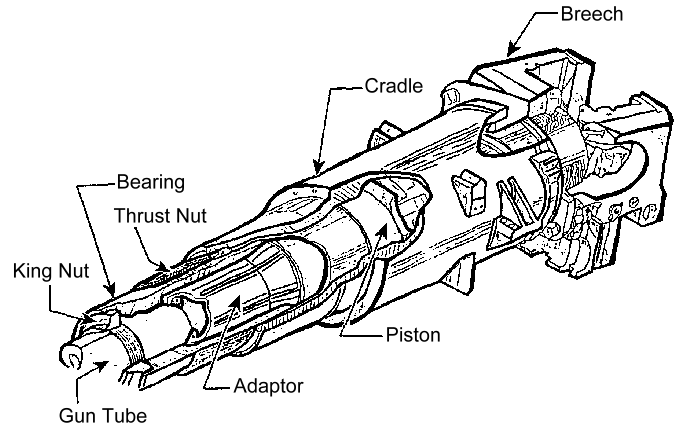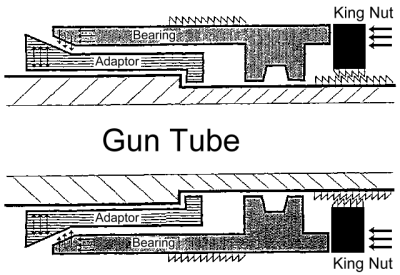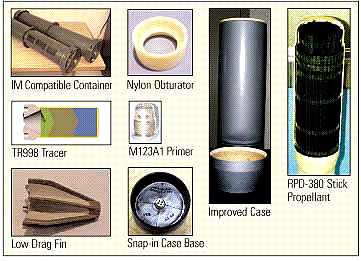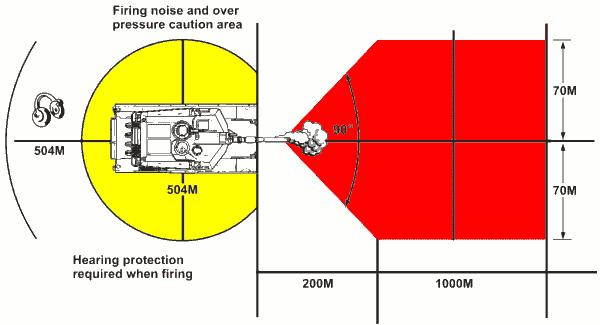The 120mm ammunition cartridge case is made of a combustible (cellulose fiber) material.
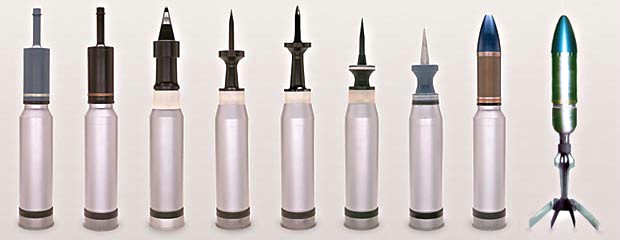
KEW Armor Piercing, Fin Stabilized, Discarding Sabot - Tracer (APFSDS-T)
The KEW family of 120mm rounds was developed for the Egyptian Army's Abrams fleet.
The rounds use a tungsten alloy anti-armor penetrator.
Although there is no intent for these rounds to be released to the U.S. Army, they were all subjected to substantially the same testing, with the exception of U.S. Army User tests, required by the U.S. Army for its own ammunition.
- KEW: 1996. Tungsten Kinetic Energy round for Egypt.
- KEW-A1: 2000.
- KEW-A2: 2003.
M829 Armor Piercing, Fin Stabilized, Discarding Sabot - Tracer (APFSDS-T)
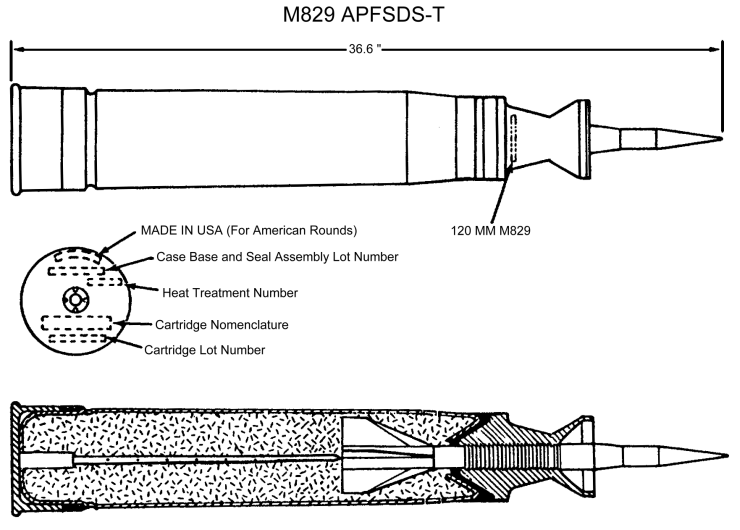 Use:
Use:
The M829 is a kinetic energy, armor-piercing anti-tank round intended for use with the 120mm smooth bore M256 cannon.
Function:
The M829 is loaded and fired from the 120mm tank gun in the normal manner.
Upon initiation of the electric primer in the breech of the weapon, the resulting flash ignites the propelling charge and combustible case, generating gases which drive the projectile from the gun and ignite the tracer.
The rear seal of the sabot prevents gas leakage between the sabot segments and the driving forces (gas) propelling the subprojectile downbore.
Upon leaving the gun, aerodynamic forces cause the sabot to separate from the subprojectile allowing the subprojectile to continue on a true course to target while the sabot segments fall quickly to earth.
Target penetration is affected strictly by the high kinetic energy of the subprojectile's high density core when it impacts.
Description:
The M829 is a U.S. designed and developed 120mm APFSDS-T cartridge ("sabot round").
The complete round contains a propulsion system consisting of a metal cartridge case base with combustible sidewall, granular propellant within a containment device to prevent spillage, and M125 primer, while the projectile consists of the subprojectile and aluminum sabot.
The depleted uranium (DU) penetrator is a one piece design which is assembled into the sabot by means of grooves.
There is a six bladed aluminum fin with tracer assembly fitted to the rear of the subprojectile and a windshield fitted to the front.
The aluminum sabot is composed of four 90° noninterchangeable segments with internal grooves matching those on the outer diameter of the subprojectile.
The sabot has a silicone rubber seal at the rear to prevent leakage of gases.
The M829 is a full service round which may only be fired during war emergency.
Type Classification Date: November 1984.
- Length: 36.8 in (934 mm)
- Weight: 41.2 lb (18.7 kg)
- Projectile Color: Black with white markings.
- Peak Chamber Pressure: 73,950 psi at 70°F (5,100 bars at 21°C)
- Nominal Velocity: 5,510 ft/sec (1,679 m/s)

M829A1 Armor Piercing, Fin Stabilized, Discarding Sabot - Tracer (APFSDS-T)
 Use:
Use:
The M829A1 is a kinetic energy, armor-piercing anti-tank round intended for use with the 120mm smooth bore M256 cannon.
This round was dubbed the "Silver Bullet" by soldiers during Operation Desert Storm.
Function:
The M829A1 is loaded and fired from the 120mm tank gun in the normal manner.
Upon initiation of the electric primer in the breech of the weapon, the resulting flash ignites the propelling charge and combustible case, generating gases which drive the projectile from the gun and ignite the tracer.
The rear seal of the sabot prevents gas leakage between the sabot segments and the driving forces (gas) propelling the subprojectile downbore.
Upon leaving the gun, aerodynamic forces cause the sabot to separate from the subprojectile allowing the subprojectile to continue on a true course to target while the sabot segments fall quickly to earth.
Target penetration is affected strictly by the high kinetic energy of the subprojectile's high density core when it impacts.
Description:
The M829A1 is a U.S. designed and developed 120mm APFSDS-T cartridge ("sabot round").
The complete round contains a propulsion system consisting of a metal cartridge case base with combustible sidewall, granular propellant within a containment device to prevent spillage, and M129 primer, while the projectile consists of the subprojectile and aluminum sabot.
The depleted uranium (DU) penetrator is a one piece design which is assembled into the sabot by means of grooves.
There is a six bladed aluminum fin with tracer assembly fitted to the rear of the subprojectile and a windshield fitted to the front.
The aluminum sabot is composed of three 120° noninterchangeable segments with internal grooves matching those on the outer diameter of the subprojectile.
The sabot has a silicone rubber seal at the rear to prevent leakage of gases.
- Length: 38.75 in (984 mm)
- Weight: 46.0 lb (20.9 kg)
- Projectile Color: Black with white markings.
- Peak Chamber Pressure: 96,000 psi @ 120°F. 82,650 psi @ 70°F.
- Nominal Velocity: 5,150 ft/sec (1,569 m/s)
M829A2 Armor Piercing, Fin Stabilized, Discarding Sabot - Tracer (APFSDS-T)
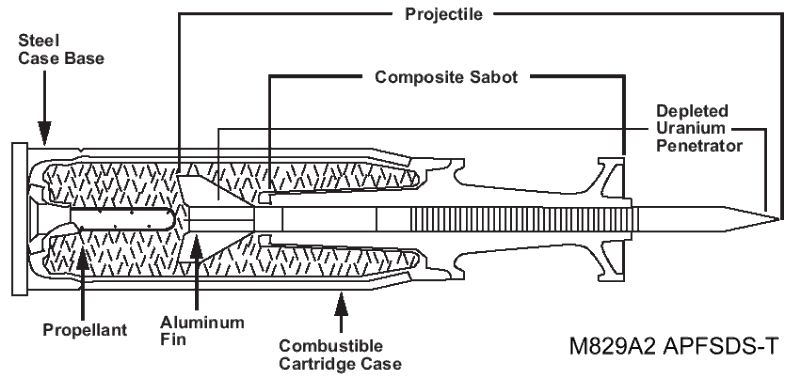
The 120mm M829A2 cartridge was designed to be the most effective anti-armor kinetic energy round fired by the M256 120mm smooth bore cannon of Abrams Main Battle Tank.
The propellant system consists of a combustible cartridge case mounted on a steel stub base and filled with kerfed propellant.
The propellant is ignited by a M129 electric primer.
The projectile incorporated a segmented graphite reinforced plastic sabot held in place by a plastic band which separates in flight to allow the discarding of the sabot from the super depleted uranium (SDU) penetrator.
A synthetic rubber seal is molded to the base of the sabot assembly to prevent the forward escape of hot propellant gases.
The M829A2, although using similar components of the M829A1 APFDS-T, has been technologically improved to provide significantly greater armor penetration capability than the older round.
The M829A2's performance gains, while classified, result from several novel features.
These include the use of new manufacturing process to improve the structural quality of the depleted uranium penetrator, the use of a carbon-epoxy composite for the sabot (a world-wide first in a projectile this large) and a special manufacturing process which partially cuts the propellant charge to allow it to behave ballistically like a granular propellant bed, while loading like a stick charge.
Combined, these features increase the muzzle velocity of the M829A2 approximately 100 m/sec greater than the M829A1, while operating at slightly lower pressure.
Type Classification Date: September 1992. Unit cost: $4,000 (Fiscal Year 2000).
- Length: 38.74 in (984 mm)
- Weight: 44.88 lb (20.4 kg)
- Projectile Color: Black with white markings.
- Nominal Velocity: 5,512 ft/sec (1,680 m/s)

U.S. Army Photo, 1060x451, 27K, JPG
M829A3 Armor Piercing, Fin Stabilized, Discarding Sabot - Tracer (APFSDS-T)
The 120mm M829A3 cartridge is the follow-on to the M829A2 APFSDS-T cartridge.
The M829A3 is the most effective anti-armor kinetic energy round fired from the M256 120mm smoothbore cannon mounted on the Abrams Main Battle Tank.
This cartridge has been specifically developed to counter advances in armor protection technologies, to include explosive reactive armor.
The propulsion system consists of a high-energy propellant and a combustible cartridge case with an electric primer.
The projectile system consists of a Depleted Uranium (DU) penetrator mated to a drag reducing windshield and flight stabilizing multi-bladed tail fin, all secured for launch by a composite sabot.
The M829A3 utilizes similar components to the M829A1 and M829A2 series of APFSDS-T cartridges, but incorporates technological advancements to provide significantly more effective anti-armor capability than the predecessor designs.
This round incorporates revolutionary advances in technology and represents the most lethal anti-armor tank cartridge in production/inventory.
This is a war reserve item used in combat.
Type Classification Date: March 2003. Unit cost: $8,508 (Fiscal Year 2009).
- Length: 38.74 in (984 mm)
- Weight: 56.0 lb (25.4 kg)
- Projectile Color: Black with white markings.
M830 High Explosive Anti-Tank Multi-Purpose Tracer (HEAT-MP-T, or MPAT)
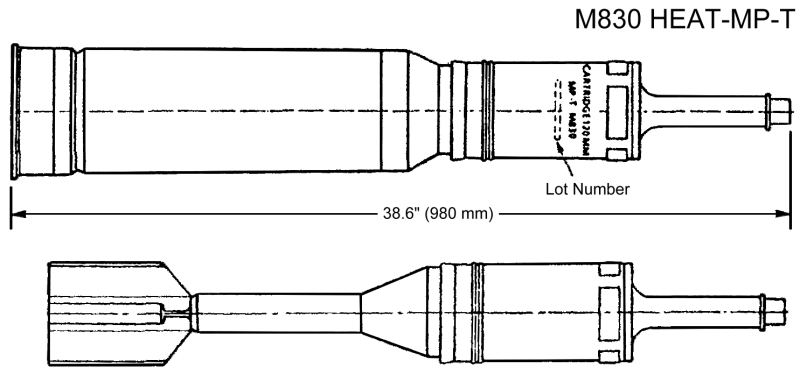
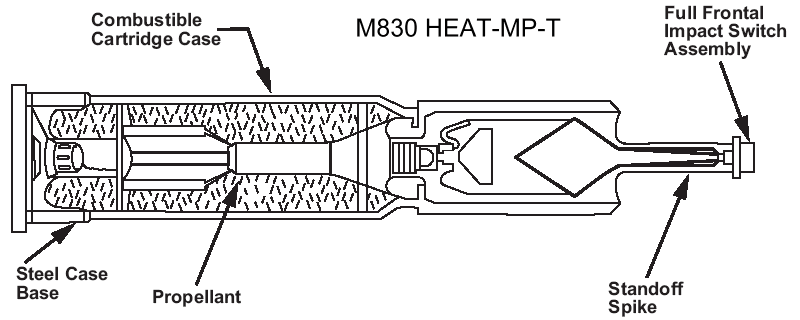 Use:
Use:
The M830 120mm tank cartridge is a high explosive multi-purpose cartridge which has anti-armor and anti-personnel capabilities.
Function:
The M830 is loaded and fired in the normal manner from the 120mm M256 smoothbore tank gun.
When the electric primer in the breech of the weapon is initiated, the resulting flash ignites the propelling charge and combustible case.
This generates gases which drive the projectile from the gun and ignite the tracer element.
Upon impact, one of the fuze sensors is initiated.
The fuze then detonates the high explosive shaped charge which collapses the cone assembly creating a high velocity focused shock wave and a jet of metal particles that penetrate the target.
Anti-personnel capability results from fragmentation of the projectile body sidewall.
The round has both nose and shoulder activation capability to provide full frontal area plus graze initiation.
Therefore the round will function even where bar armor is employed.
The round's blast and fragmentation effects make it effective against targets other than armor such as bunkers and anti-personnel.
Description:
The M830 cartridge is a direct translation of the German DM12A1 round with the exception that a U.S. designed fuzing system and explosive (Comp A3, Type II) is used.
The round consists of a steel body loaded with explosive surrounding a copper shaped charge liner and wave shaper.
The projectile embodies a steel spike with a shoulder and nose switching mechanism for full frontal area functioning and graze impact which initiates a base detonating fuze.
The fuse is located at the rear of the projectile body.
The projectile body has a copper obturator, boom and fin assembly for flight stabilization.
The fin contains a tracer for projectile to target visual tracking.
The propellant system utilizes a metal cartridge case base with a rubber obturator at the stub case mouth.
M123A1 primer and a combustible wall which encapsulates stick propellant within six containment devices to prevent spillage should breakage or separation occur.
Type Classification Date: November 1984.
- Length: 38.6 in (980 mm)
- Weight: 53.4 lb (24.2 kg)
- Projectile Color: Black with yellow markings.
- Peak Chamber Pressure: 69,600 psi at 70°F (4,850 bars at 21°C).
- Nominal Velocity: 3,740 ft/sec (1,140 m/s)
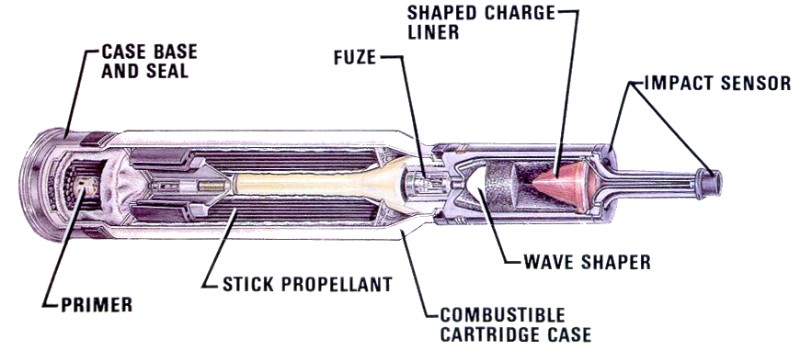
U.S. Army Photo, 870x500, 86K, JPG
M830A1 High Explosive Anti-Tank Multi-Purpose Tracer (HEAT-MP-T, or MPAT)
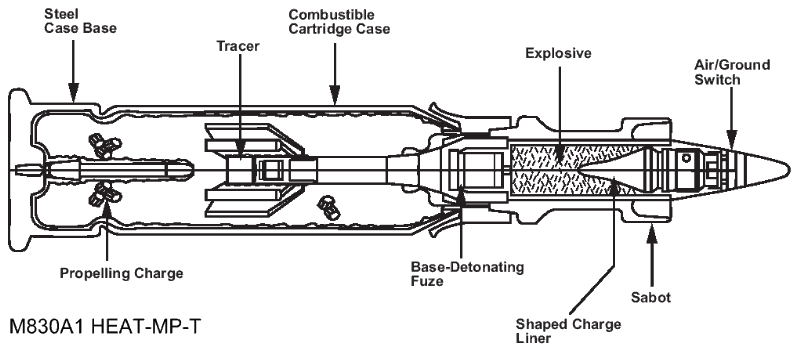
The 120mm M830A1 cartridge is effective against light armor, air defense and materiel.
This round is fired from the M256 120mm cannon mounted on the Abrams tank.
Appropriate targets include lightly armored vehicles with reactive armor, helicopters, buildings, and bunkers, the side and rear aspects of tanks, and dismounted anti-tank and automatic weapons teams.
The fixed round utilizes a combustible cartridge case affixed to a steel stub and loaded with granular propellant.
The fin-stabilized, high chrome alloy steel projectile body is press-loaded with explosive, a precision copper liner and booster.
The base element is armed during launch and initiated by an impact switch, or proximity sensor, depending upon the operational mode selected by the tank crew.
Arming is accomplished through the ballistic environment of firing, set back, and deceleration.
When fired in the air mode, a black puff of smoke is produced when the proximity sensor and fuze function.
This permits the crew to observe when and where the round functions in relation to the target.
The production and fielding of the M830A1 provides increased accuracy when compared to the currently fielded M830 HEAT-MP-T cartridge, due to reduced time of flight.
The M830A1 provides the individual tank crew with the self-defense capability to engage and defeat attacking helicopter platforms.
The M830A1 replaces the currently fielded M830 round to provide significantly enhanced capability to the 120mm gun tank fleet.
Type Classification Date: September 1992. Unit cost: $4,659 (Fiscal Year 2000).
- Length: 38.7 in (983 mm)
- Weight: 50.1 lb (22.7 kg)
- Projectile Color: Black with yellow markings.
- Nominal Velocity: 4,626 ft/sec (1,410 m/s)
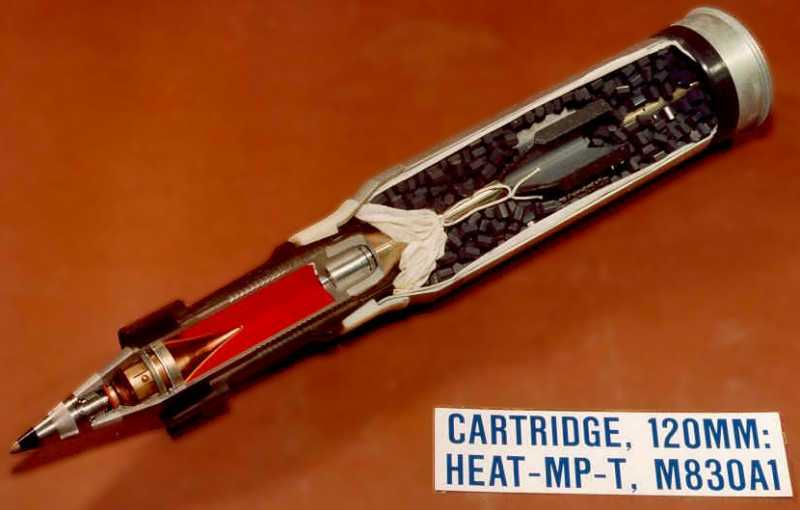
U.S. Army Photo, 952x784, 55K, JPG
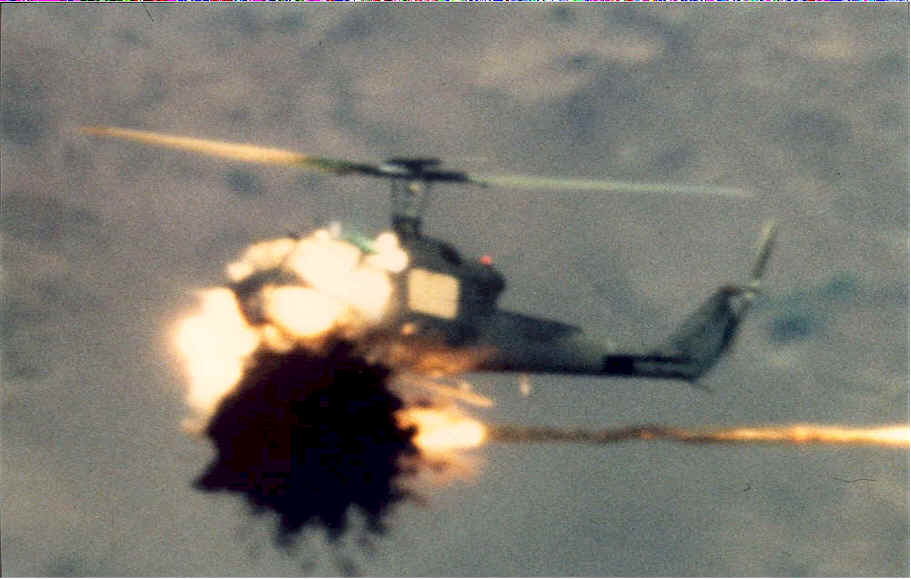
M831 Target Practice - Tracer (TP-T)
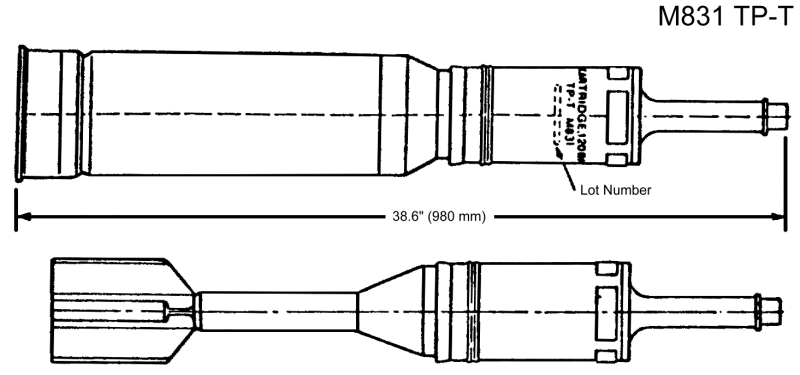 Use:
Use:
This cartridge is a target practice round to simulate the ballistics of the M830 HEAT-MP-T.
Function:
The M831 is loaded and fired in the normal manner from the 120mm M256 smoothbore tank gun.
When the electric primer in the breech of the weapon is initiated, the resulting flash ignites the propelling charge and combustible case.
This generates gases which drive the projectile from the gun and ignites the tracer element.
The flight characteristics simulate those of the service round, but does not result in an explosion or penetration upon target impact.
Description:
The M831 cartridge external appearance is identical to that of the M830 HEAT-MP-T service round.
Internally the round does not contain any explosives, shaped charge liner base fuze or nose cap.
The round consists of a steel body with aluminum spike and copper obturator, in addition to a fin and boom assembly with tracer.
The complete round propellant system comprises a stub metal case with combustible sidewall and M123A1 primer.
The propellant is a single perforated stick propellant and is bagged with additional segments fitted over each fin.
The propellant system utilizes a metal cartridge case with a rubber obturator at the stub case mouth, M123A1 primer, and a combustible wall which encapsulates stick propellant within six containment devices to prevent spillage should breakage or separation occur.
Type Classification Date: April 1984.
- Length: 38.6 in (980 mm)
- Weight: 53.4 lb (24.2 kg)
- Projectile Color: Blue with white markings.
- Peak Chamber Pressure: 69,600 psi at 70°F.
- Nominal Velocity: 3,740 ft/sec (1,140 m/s)
M831A1 Target Practice - Tracer (TP-T)
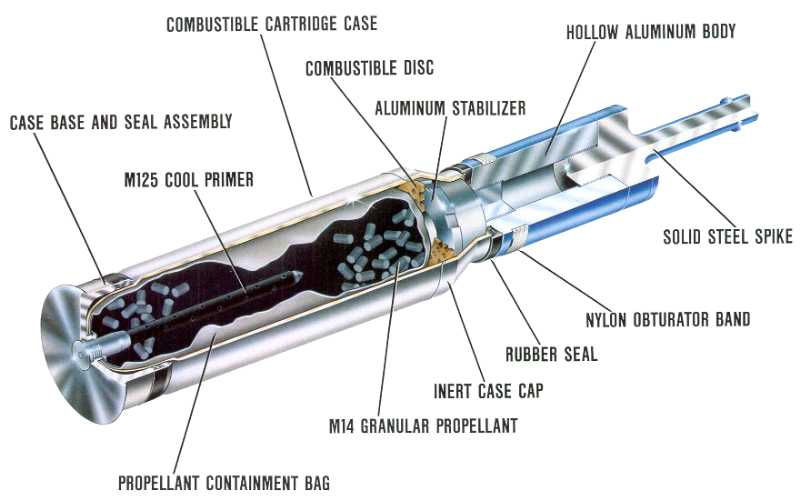
U.S. Army Photo, 880x645, 104K, JPG
The 120mm M831A1 cartridge is a target practice round that simulates the ballistics of the M830 chemical energy service round.
The M831A1 replaced the earlier M831 TP-T round. This round is fired from the M256 120mm smoothbore cannon on the M1A1/M1A2 Abrams tank.
The projectile is inert and is composed of a steel spike aluminum body, ring, stabilizer, nylon obturator and tracer.
The stabilizer spins the round in flight.
The projectile has no energetic components except for the tracer.
The M831A1 is the successor to the M831 training cartridge. The M831A1 is a re-design of the M831 that provided a substantial cost saving.
This is a training unique item; not used in combat.
Tank crews conduct live fire training with this round to meet and maintain gunnery proficiency.
Type Classification Date: 1993. Unit cost: $721 (Fiscal Year 2005).
- Length: 38.62 in (981 mm)
- Weight: 50.5 lb (22.9 kg)
- Projectile Color: Blue with white markings.
M865 Target Practice Cone Stabilized Discarding Sabot - Tracer (TPCSDS-T)
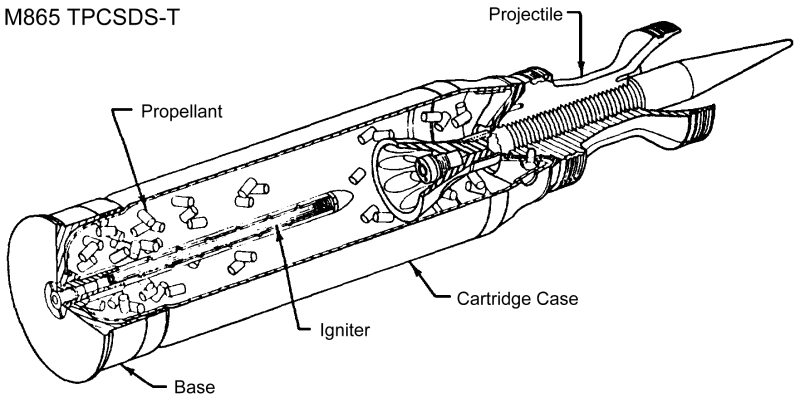 Use:
Use:
The M865 cartridge is a kinetic energy, target practice round for use with the 120mm smoothbore M256 cannon.
It is designed to simulate the M829-series APFSDS-T service round characteristics at reduced maximum ranges to allow practice firings on short-range proving grounds and training areas.
Even though this is a target practice round, the core can cause damage and penetrate armored vehicles.
Function:
The M865 is loaded and fired from the 120mm tank gun in the normal manner.
Upon initiation of the electric primer in the breech of the weapon, the resulting flash ignites the propelling charge and combustible case generating gases which drive the projectile from the gun and ignite the tracer.
The rear seal of the sabot prevents gas leakage between the sabot segments and the driving forces (gases) propelling the projectile down bore.
Upon leaving the gun, aerodynamic forces cause the sabot to separate from the subprojectile allowing it to continue to target, while the sabot segments fall quickly to earth.
The tail cone segment of the subprojectile, due to the nine hole (old design) or six slot arrangement, causes aerodynamic slowing of the subprojectile to limit its range to 8,000 m.
Description:
The M865 contains a propulsion system consisting of a stub metal case with combustible sidewall, granular propellant, and electric M125 primer, while the projectile consists of the subprojectile and aluminum sabot.
The core is a one-piece steel design with a tail cone assembly which is assembled into the sabot by means of threads.
The tail cone contains nine holes or six slots which in conjunction with the conical shape provide stabilization.
Reduced range is achieved by the aerodynamic blocking effect of the holes or slots.
The tail cone assembly also contains a tracer.
The aluminum sabot is composed of three 120° noninterchangeable segments with internal screw threads matching those on the outer diameter of the subprojectile.
The sabot has a silicone rubber seal at the rear to prevent gas leakage.
The weight of the complete cartridge is approximately 19.0 Kg (41.9 lb) and the weight of the subprojectile is approximately 3.2 Kg (7.1 lb).
This is a training unique item not used in combat.
Training with this round simulates the firing of the Army's most lethal armor-defeating kinetic energy round in support of Army readiness objectives.
Type Classification Date: July 1984. Unit cost: $1,121 (Fiscal Year 2009).
- Length: 34.7 in (881 mm)
- Weight: 41.9 lb (19.0 kg)
- Projectile Color: Blue with white markings.
- Peak Chamber Pressure: 70,325 psi at 70°F (4,850 bars at 21°C).
- Nominal Velocity: 3,740 ft/sec (1,140 m/s)
M908 High Explosive Obstacle Reduction (HE-OR-T, or MPAT-OR)
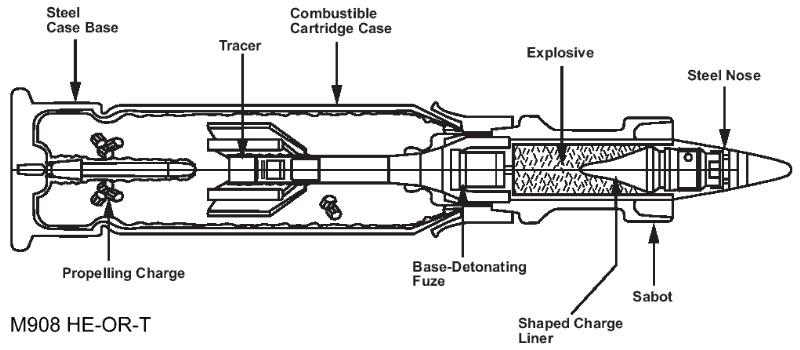
 Use:
Use:
The M908 round is primarily used to reduce concrete obstacles into rubble that is small enough to be cleared by either unit organic equipment or external support.
Live-fire test results have shown that this round is also effective against concrete bridge pylons.
Units now have the capability to destroy bridges or damage them enough to greatly hinder their carrying capacities.
This action could be used to create an obstacle that would greatly restrict or impede enemy movement.
Function:
Loading and firing procedures for the M908 are basically the same as those used for all 120mm tank rounds.
The M908 contains a high-explosive filler with a three-part fusing system.
This fusing system consists of the M774 base element, flexible communications circuit, and frontal impact switch assembly.
Upon impact, the steel nose penetrates the target, and a firing signal is sent to the M774 fuze.
This initiates the firing sequence and full detonation occurs.
The steel nose penetration allows the munition to explode inside the target.
When firing at concrete obstacles, this penetration will reduce the obstacle more efficiently.
Description:
The M908 is produced by replacing the proximity switch nose of existing M830A1 rounds with a hard steel nose.
The round is similar in appearance to the M830A1 MPAT round.
The weight of the round and center of gravity are nearly identical to the M830A1 MPAT round.
Major differences include:
- A steel nose cap painted yellow in place of the proximity sensor.
- Markings on the projectile.
- Markings on the case base that identify the round as the HE-OR-T M908.
- Length: 38.7 in (983 mm)
- Weight: 50.1 lb (22.7 kg)
- Projectile Color: Black with yellow letters and a yellow steel nose.
- Nominal Velocity: 4,626 ft/sec (1,410 m/s)
M1002 Target Practice Multipurpose Projectile - Tracer (TPMP-T, or MPAT-TP-T)

The 120mm M1002 is a target practice cartridge that simulates the size, weight, ballistics and the loader's function of setting the nose switch of the M830A1 multi-purpose chemical energy cartridge.
This cartridge is fired from the M256 120mm smooth bore cannon on the M1A1/M1A2/M1A2 SEP Abrams Tank.
The projectile is inert and composed of an aluminum body, steel nose with dummy plastic switch, aluminum conical stabilizer, aluminum sabot, nylon obturators and tracer.
The stabilizer imparts spin to the projectile in flight for stabilization and provides the mechanism to limit the projectile's maximum range.
This is a training unique item not for use in combat.
The M1002 will replace the M831A1 cartridge.
Tank crews will conduct live fire training with the cartridge to achieve and maintain gunnery proficiency.
Type Classification Date, Limited Production: June 2004.
Type Classification Date: June 2006. Unit cost: $1,650 (Fiscal Year 2009).
- Length: 38.74 in (984 mm)
- Weight: 46.0 lb (20.9 kg)
- Projectile Color: Black with yellow markings and yellow tip.
M1028 Canister

The 120mm M1028 Canister is a muzzle action anti-personnel tank cartridge.
This cartridge is fired from the 120mm main gun of the M1A1/M1A2 Abrams tank and is effective at ranges less than 700 meters.
The baseline design utilizes a payload of approximately 1,100 tungsten balls that are expelled from the projectile casing upon muzzle exit, similar to a shotgun shell.
Unlike previous antipersonnel cartridges, the M1028 does not have a fuze; it is intended to be a low-cost, low-technology cartridge.
The M1028 uses a combustible cartridge case and propulsion-ignition system common to the current 120mm tank ammunition.
This is a training standard item used in both training and combat.
Type Classification Date: December 2004. Unit cost: $2,000 (Fiscal Year 2009).
- Length: 30.67 in (779 mm)
- Weight: 50.51 lb (22.9 kg)
- Projectile Color: Olive drab with white markings.

165x650, 137K, PNG

